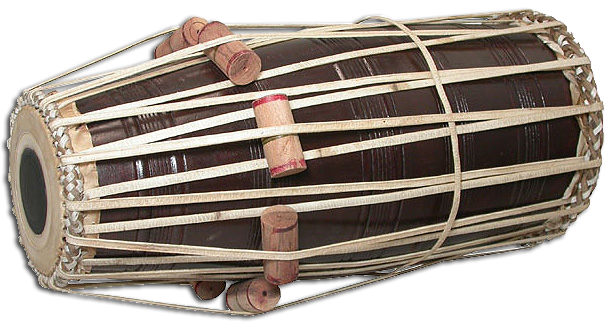Pakhavaj belongs to the percussion instrument family. It is mostly used in North Indian classical music. It is quiet similar to Mridangam and is also termed as Mridangam in North India.
Pakhavaj was derived from “Dvaf†drum and was extensively used in Mughal courts. It was a predominant drum and was used quiet often. It was used in vocal music along with the instruments as the “Bin†and the “Rebabâ€.
Pakhavaj is a typical barrel shaped drum and it comes in various sizes. The length is from around 66 to 76 cms and the diameter is around 20 to 30 cms. Pakhavaj‘s head are designed in a slightly differently. The outer layer of the skin is cut a little more than the typical Mridangam, which leaves more of the second layer exposed hence allows the player area a little wider.

The right head is 16 to 19 centimeters in diameter and the left is around 25 to 25 centimeters. Before any performance wheat flour is placed on the head. The leather used on the heads of Pakhavaj and Mridangam is also different and also the tensions on their surfaces.
Typically the wood used as cylindrical blocks between the leather braces and also the body of the Pakhavaj are bigger and some of the other instrument .
Like the Mridangam, the Pakhavaj is kept horizontally on the ground or on the lap and played with the hands, in other words, it is an Ankya drum. Tuning is done just like Tabla, by means of tuning blocks (Gattha) as well as striking on the Gajra.
As this instrument was closely linked with the Dhrupad style of singing and the Bin, it is the relatively rare bin performances today which are still accompanied by the Pakhavaj, as are the more frequent occasions of dhrupad singing. Gopal Dass, Madhavrao Alkutkar, and Lakshmi Narayan Pawar have been among the few notable Pakhavaj players in recent times.
Efforts are, however, being made at various levels to revive it, because the Pakhavaj has a fine dignity and sobriety of tone and technique, not possible in the Tabla. As with the tabla, the pakhavaj rhythms are taught by a series of syllables known as Bol. The playing technique varied from that of tabla in many aspects. In the bass face, the artist hits with his whole palm instead of the finger tip hitting which is done in tabla. In the treble face, the artist hits his whole palm with the fingers properly placed on the skin to produce different bols.
In traditional pakhavaj styles a student would learn a number of different strokes which produce a specific sound. These are remembered and practiced with corresponding syllables.
